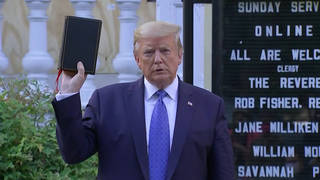
Related
Topics
Guests
- Eugene Jareckiaward-winning documentary filmmaker, author and activist. He created the Trump Death Clock billboard in New York City’s Times Square.
As the death toll from COVID-19 in the United States surpasses 80,000, an unusual new billboard called the Trump Death Clock in New York City’s Times Square keeps tally of lives lost to government inaction. “What we found was that there was an amazing and very dark truth underlying the numbers that spoke to reckless mishandling of a pandemic by the president and his team, and we felt that ought to be quantified,” says Eugene Jarecki, the award-winning documentary filmmaker, author and activist behind the project.
Transcript
AMY GOODMAN: This is Democracy Now!, democracynow.org, The Quarantine Report. I’m Amy Goodman. As the death toll from COVID-19 in the United States surpasses 80,000 — higher than any other country in the world — an unusual new billboard called the Trump Death Clock has been unveiled in New York City’s Times Square. The 56-foot sign keeps tally of lives lost to government inaction. It was created by filmmaker Eugene Jarecki, who writes in The Washington Post that, quote, “it is time for the establishment of a national 'death clock' to measure the cost in human lives of President Trump and his team’s reckless handling of the coronavirus pandemic,” unquote.
White House Coronavirus Task Force adviser Dr. Anthony Fauci has said the virus would have been mitigated, and lives would have been saved, if social distancing guidelines had been implemented earlier. Dr. Fauci is now one of three members of the task force who have entered self-quarantine after possible exposure to the virus by one of several people who have just tested positive at the White House — among them, Vice President Pence’s press secretary, though Vice President Pence says he will be coming to the White House today. This is Dr. Fauci on CNN last month.
DR. ANTHONY FAUCI: Obviously, you could logically say that if you had a process that was ongoing and you started mitigation earlier, you could have saved lives. Obviously, no one is going to deny that. But what goes into those kinds of decisions is complicated. But you’re right. I mean, obviously, if we had, right from the very beginning, shut everything down, it may have been a little bit different. But there was a lot of pushback about shutting things down back then.
AMY GOODMAN: Reports show President Trump ignored warnings from advisers and experts as early as January about the need for urgent mitigation measures against the spread of the virus. It wasn’t until March 16th that Trump reversed his previously dismissive stance and announced new guidelines. But by then, it was too late.
Well, for more, we’re joined by Eugene Jarecki, award-winning documentary filmmaker, author, activist. He created the Trump Death Clock billboard that was unveiled in New York City’s Times Square Friday morning. We will also link to his piece in The Washington Post, “Trump’s covid-19 inaction killed Americans. Here’s a counter that shows how many.”
It’s great to have you with us, Eugene. Just explain what went into this billboard.
EUGENE JARECKI: Sure. Well, it started out actually as a website. It wasn’t a billboard; it was just an effort on the part of myself and my team to quantify what we were learning from the epidemiologists. And then we got in contact with the leading epidemiologists, on whom The New York Times had relied and the British government had relied, Drs. Jewell and Jewell, and spoke to them about their findings. And what we found was that there was an amazing and very dark truth underlying the numbers, that spoke to reckless mishandling of a pandemic by the president and his team. And we thought that ought to be quantified. And first, it became a website.
AMY GOODMAN: So, talk about — describe the website for us, where it is in Times Square.
EUGENE JARECKI: So, the website itself is called TrumpDeathClock.com, and you can go to it. Every minute, you’ll see it update. And you’ll see, very tragically, the death toll rise, that is attributable to the Trump administration’s failure to handle the outbreak as they should have.
But what was inspiring to me originally — I’m a New Yorker. And every New Yorker knows, and most visitors to New York at one time or another pass, the famous Debt Clock that hangs over the Avenue of the Americas, 6th Avenue. And that National Debt Clock stands for something. It’s symbolic, and it speaks about the country’s reckless borrowing. And it warns, in a way, just as a symbol, that there will be grave future consequences to that borrowing.
Well, I didn’t need to look far to see the grave consequences of the reckless handling of this pandemic. And so, it seemed to me that in the spirit of the Debt Clock, there ought to be a Death Clock. And it ought to be somewhere hanging for the world to see, for the media to see, and to be sort of implanted in our minds, our public imagination, as a reminder of the grave consequences of reckless leadership during a time of crisis.
AMY GOODMAN: Tell us exactly the place it is in Times Square, how you got —
EUGENE JARECKI: Sure.
AMY GOODMAN: — permission to do it, and then how you make the calculation, because, clearly, the United States would have been affected by the coronavirus, whether it was President Trump or President Obama or the next president.
EUGENE JARECKI: Yes. So, the Trump Death Clock now lives in Times Square at 43rd and 7th, at 1500 Broadway. That’s the building that it’s at.
And, you know, what we found — people read my editorial, when I was writing it for The Washington Post, and I showed it to friends and acquaintances, who were supportive of what I was thinking, but they were, you know, giving me good editorial ideas. And over time, they said, “You know, if you’re so focused on the Debt Clock, why don’t you find out about putting a Death Clock in the real world? Why just do it as a website?” And, of course, I had thought about that, but I didn’t know — my gosh, what must a billboard cost, you know, or a big clock to put up?
Well, when we poked around a little bit — friends had offered to give some support — we found that, maybe not surprisingly, billboard space is not very expensive right now, because, after all, there’s nobody on the streets in the height of a pandemic, if people are sort of living by the guidelines that they’ve been supposed to be under. And that means that billboard space in New York was much, much more affordable than one would have ever dreamt, a tiny, tiny fraction of what it usually costs to advertise in Times Square, which is one of the most expensive areas of the world.
So, some friends put together some support to really put this up, to put it up and start the ball rolling, which we hope will roll across the country. We hope that the Trump Death Clock in New York can be emulated in small towns and big cities across the country, where people can get a billboard that’s sitting dormant, or they can actually just project it. You know, those little projectors that people have, you can project it on a building, you can project it on your house, just to remind your community of what the incredible cost has been of the reckless handling of this.
And this is not just about being critical. As you say, you know, this could have happened to any president. So, the fact is, there is a specific calculation that we base the Death Clock on. We’re not just saying, “Oh, Donald Trump, you’ve been bad,” in some general, blurry way. We wanted to find the single calculation that was most damning and most specific. In other words, we looked for the most conservative number. And that number was so damning, that — you know, reasonable people will debate. The president’s defenders will say, “Oh, it was China’s fault,” or “It was the World Health Organization,” or “It was the CDC,” or blame individuals, blame anybody but the White House. Well, they can do that. Trump’s’s detractors will point to things that happened much earlier, like that his team disbanded the White House pandemic directorate in 2018, got rid of people chiefly concerned with this kind of outbreak. Or they might have pointed to — they want to say, “Well, in January and February, the intelligence services gave the president countless warnings about the need to move quickly.” That is all true, and reasonable people can debate that. But they can debate it 'til they're not reasonable.
We wanted a single calculation, and that’s the basis of the Trump Death Clock, which just looks at one period around which there is no debate, and that is the period between March 9 and March 16. And after Dr. Fauci and others made clear that they had knowledge that mitigation guidelines were not put in when they should have been, the question is, “OK, what was the cost of that?” Because when a virus is spreading exponentially, as viruses do, every second counts. And in my view, every life counts.
So the question is, “The seconds that you lost, Mr. President, while you dithered” — you know, look at South Korea. South Korea, at that same moment that we were beginning to see the outbreak of this, they instituted mitigation guidelines, and they ended up with 300 deaths to our 70,000, 80,000. You know? So, you’re in a position where the enormity of the mistake, Donald Trump made a political calculation, whatever his reasoning was. He made a bet. The bet failed, was a failure. At what cost? And at what cost being borne by the American people?
AMY GOODMAN: We’re talking to Eugene Jarecki, who has just erected the Trump Death Clock in Times Square. Eugene, have you gotten response from the administration?
EUGENE JARECKI: We have not heard from the administration. Most of what we’ve heard from, frankly, are from people who are detractors of the president, who wish that we had used a higher number. They say, “Your Death Clock only shows that the administration is sort of attributable to 60% of the death toll in America,” because that’s what it shows.
Basically, Drs. Jewell and Jewell, in the piece they published in The New York Times and in other releases of their findings, said, had the president and his team moved on March 9 rather than March 16, 60% of American lives would have been saved. That’s a harrowing statistic, that puts us today, at this moment, at 48,337 deaths could have been averted had mitigation guidelines been put in place earlier. To me, that is damning enough.
And to try to go earlier and enter the debate, the big echo chamber of hyperbolic claims that will go in both directions, they may even have truth in them, but the president will try to use that to get out of accountability. The goal here is to require accountability, to demand it. Amy, thousands of people lost their lives needlessly. And in their name, we must demand not just accountability, but more responsible and more responsive leadership, going forward.
AMY GOODMAN: Let me go to the Trump Coronavirus Calendar, that was produced by The Recount and captures those months of downplaying and denial, before President Trump pivoted to coronavirus crisis mode. It begins on January 22nd.
PRESIDENT DONALD TRUMP: We have it totally under control. It’s one person coming in from China. … We think we have it very well under control. …
We pretty much shut it down, coming in from China. … You know, in April, supposedly it dies, with the hotter weather. … When it gets warm, historically, that has been able to kill the virus. … The people are getting better. They’re all getting better. … And the 15, within a couple of days, is going to be down to close to zero. … It’s going to disappear one day. It’s like a miracle. It will disappear. … And you’ll be fine. …
Now, they’re going to have vaccines, I think, relatively soon. … Not only the vaccines, but the therapies. Therapies is sort of another word for cure. … We’re talking about very small numbers in the United States. … Our numbers are lower than just about anybody. … It’s really working out, and a lot of good things are going to happen. … And we are responding with great speed and professionalism. … It’s going to go away. … Yeah, no, I don’t take responsibility at all. … We’re going to all be great. We’re going to be so good. …
This came up. It — we came up so suddenly. … This is a pandemic. I felt it was a pandemic long before it was called a pandemic. All you had to do was look at other countries. …
The coronavirus. You know that, right? Coronavirus. This is their new hoax. We have 15 people in this massive country. And because of the fact that we went early — we went early. We could have had a lot more than that. We’re doing great. Our country is doing so great.
AMY GOODMAN: So, there you have President Trump in that lead-up, he who repeatedly says that he was the first to institute that Chinese travel ban. But if that is true, in late January, the question is: Where was the gearing up for the tests, and where was the gearing up for making the personal protective equipment that so many in hospitals all over this country, not to mention people all over the country, in general, need, masks? Why wasn’t that begun at that time, clearly a life-saving measure?
Now you have, to this day, President Trump and his new press secretary mocking the need for massive testing in this country, but we see, over the weekend, with three people very close to the White House testing positive for COVID, that what the president and the vice president are saying is, “We’re getting tested every day,” and everyone is being tested regularly there — which seems like a perfect model for how the rest of the country should be, that we also should be able to have access regularly to tests, especially as the country reopens. Eugene Jarecki, your final comments on what this means, going forward?
EUGENE JARECKI: Well, the president is conducting himself like an emperor. You know, this is where we see the breakdown of American democracy. And Donald Trump is sort of the epitome of what it looks like when you no longer have a democratic process at work.
In a democratic process, you have a separation of powers, let alone between the branches. And then, within those branches, there are experts who are brought in to represent areas of public policy with all that they have learned and all that they know from the full time they devote to it.
Donald Trump steps in. Then, like any sort of would-be despot — I’ve seen a very funny clip on Trevor Noah, where Trevor Noah compares the way that Donald Trump speaks about his brain and how smart he is and how great he is and how everything he does is great and nothing he does is wrong and everything is working in the country. That delusionary speak that he engages himself in, Trevor Noah compares that to Idi Amin, literally shows clips back and forth between the African dictator and Donald Trump, back and forth, back and forth. And it just makes clear we are dealing with a person who thinks he’s a dictator, and we’re dealing with a person whose dictatorial leanings have caused a massive human death toll in this country, as dictators often do, and as democracies are supposed to protect against.
AMY GOODMAN: We have 10 seconds.
EUGENE JARECKI: When you reject the experts and you make yourself the focus of everything, you screw up, like the president did here. And the Trump Death Clock is meant to hold him accountable and to demand a better path forward. We hope he takes it.
AMY GOODMAN: Eugene Jarecki, I want to thank you so much for being with us, award-winning documentary filmmaker, author, activist, who created the Trump Death Clock website and the billboard that’s been unveiled in New York City’s Times Square.
That does it for our show. Democracy Now! is working with as few people on site as possible. The majority of our amazing team is working from home. Democracy Now! is produced with Renée Feltz, Mike Burke, Deena Guzder, Libby Rainey, Nermeen Shaikh, Carla Wills, Tami Woronoff, Charina Nadura, Sam Alcoff, Tey-Marie Astudillo, John Hamilton, Robby Karran, Hani Massoud, Adriano Contreras and María Taracena. Our general manager is Julie Crosby. Special thanks to Becca Staley, Miriam Barnard, Denis Moynihan, Paul Powell, Mike DiFilippo, Miguel Nogueira, Hugh Gran, David Prude. I’m Amy Goodman. Thanks for joining us.












Media Options